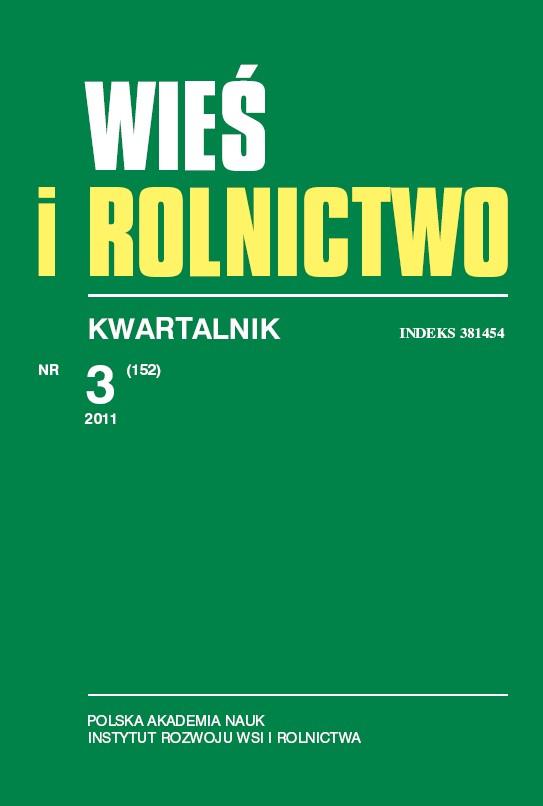The role of institutions in the process of promoting and developing business activity in rural areas
DOI:
https://doi.org/10.53098/wir.2011.3.152/06Keywords:
rural entrepreneurship, sources of financing, financial gap, institutions, external environment of entrepreneurship, KSOWAbstract
The article analyzes the role of institutions in the development of business activity in rural areas and in assistance available to rural enterprises. It also defines the most significant institutional conditions that contribute to or hamper the establishment and development of enterprises in rural areas. Basing on the results of her own investigations, the author of the article claims that it is necessary to introduce an innovative, comprehensive network of support for enterprises, which would cover the stage of creation of a concept for a business and the shaping of crucial business competencies, financial aid and advisory guidance for the already operating rural firms. The author suggests that for the purpose of implementing such a system it would be advisable to use the National Rural Areas' Network (KSOW).References
Doing Business 2011, 2011. Raport Banku Światowego, Washington D.C.
Drucker P.F., 2002: Discipline of Innovation. „Harvard Business Review”, August.
Economic Freedom of the World, 2010. Annual Report. J.G. Gwartney, J.C. Hall, R. Lawson, Economic Freedom Network (www.freetheworld.om).
Entreprenurship Survey of the EU25. Secondary analysis. Poland (http://ec.europa.eu/enterprise/policies/sme/files/survey/static2008/poland_static_en.pdf).
Fukuyama F., 2003: Kapitał społeczny. W: Kultura ma znaczenie. Red. L.E. Harrison, S.P. Huntington. Zysk i S-ka, Kraków.
Gorynia M., 1999: Przedsiębiorstwo w nowej ekonomii instytucjonalnej. „Ekonomista” 6, Miscellanea.
Kent C.A., 1991: Rola przedsiębiorcy w gospodarce. W: D.R. Kamerschen, R.B. McKenzie, C. Nardinelli: Ekonomia. Fundacja Gospodarcza NSZZ Solidarność, Gdańsk.
Models to Reduce the Disproportionate Regulatory Burden on SMEs, 2007. Report of the Expert Group. Komisja Europejska, Executive Report, maj.
North D.C., 1997: Institutions, Institutional Change and Economic Performance. Cambridge University Press, New York.
Nurzyńska I., 2011: Fundusze Unii Europejskiej a system finansowania inwestycji ze środków publicznych w Polsce. IRWiR PAN, Warszawa.
Ośrodki innowacji i przedsiębiorczości w Polsce, 2010. Raport PARP, Warszawa.
Przedsiębiorczość w Polsce, 2010: Raport Ministerstwa Gospodarki, Warszawa.
Putnam R.D., 2008: Samotna gra w kręgle. Upadek i odrodzenie wspólnot lokalnych w Stanach Zjednoczonych. Wydawnictwa Akademickie i Profesjonalne, Warszawa.
Samuelson P., Nordhaus W.D., 1989: Economics. McGraw-Hill Book Company, New York.
Schumpeter J.A., 1995: Kapitalizm, socjalizm, demokracja. Wydawnictwo Naukowe PWN, Warszawa.
Sierocińska K.: Kapitał społeczny. Definiowanie, pomiar i typy (http://www.inepan.waw.pl/pliki/studia_ekonomiczne/Studia%202011%201%204%20sierocinska.pdf).
Strategia lizbońska, 2000 (http://www.euractiv.com/en/future-eu/lisbon-agenda/article-117510).
Szczepaniec M., 2007: Wielkość firmy a wzorce korzystania z usług bankowych. Bank i Kredyt, lipiec (http://www.bankikredyt.nbp.pl/content/2007/2007_07/szczepaniec.pdf).
The Global Competitiveness Report 2009–2010, 2011. WEF, styczeń. Theory and Evidence, 2006. Volume I. The SME Financing Gap, OECD.
Understanding and Measuring Social Capital: a Multidisciplinary Tool for Practitioners. T I., 2002. World Bank.
Valdez J.: The entrepreneurial ecosystem: toward a theory of new business formation (http://www.sbaer.uca.edu/research/sbida/1988/PDF/11.pdf).
Warunki powstawania i działania oraz perspektywy rozwojowe polskich przedsiębiorstw powstałych w latach 2005–2009, 2011. GUS, Warszawa.
Wilkin J., 2005: Teoria wyboru publicznego – homo oeconomicus w sferze polityki. W: Teoria wyboru publicznego. Wstęp do ekonomicznej analizy i funkcjonowania sfery publicznej. Red. J. Wilkin. Wydawnictwo Naukowe Scholar, Warszawa.
Downloads
Article file downloads
Pages
How to Cite
Issue
Section
License
Copyright (c) 2011 Wieś i Rolnictwo

This work is licensed under a Creative Commons Attribution 4.0 International License.










